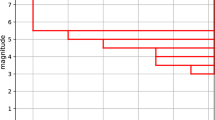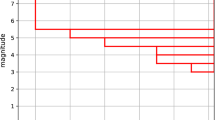Abstract
The catalog of Kamchatka earthquakes is represented as a probability space of three objects {Ω, \( \tilde F \) P}. Each earthquake is treated as an outcome ω i in the space of elementary events Ω whose cardinality for the period under consideration is given by the number of events. In turn, ω i is characterized by a system of random variables, viz., energy class ki, latitude φ i , longitude λ i , and depth h i . The time of an outcome has been eliminated from this system in this study. The random variables make up subsets in the set \( \tilde F \) and are defined by multivariate distributions, either by the distribution function \( \tilde F \) (φ, λ, h, k) or by the probability density f(φ, λ, h, k) based on the earthquake catalog in hand. The probabilities P are treated in the frequency interpretation. Taking the example of a recurrence relation (RR) written down in the form of a power law for probability density f(k), where the initial value of the distribution function f(k 0) is the basic data [Bogdanov, 2006] rather than the seismic activity A 0, we proceed to show that for different intervals of coordinates and time the distribution f elim(k) of an earthquake catalog with the aftershocks eliminated is identical to the distribution f full(k), which corresponds to the full catalog. It follows from our calculations that f 0(k) takes on nearly identical numeral values for different initial values of energy class k 0 (8 ≤ k 0 ≤ 12) f(k 0). The difference decreases with an increasing number of events. We put forward the hypothesis that the values of f(k 0) tend to cluster around the value 2/3 as the number of events increases. The Kolmogorov test is used to test the hypothesis that statistical recurrence laws are consistent with the analytical form of the probabilistic RR based on a distribution function with the initial value f(k 0) = 2/3. We discuss statistical distributions of earthquake hypocenters over depth and the epicenters over various areas for several periods
Similar content being viewed by others
References
Bogdanov, V.V., A Probabilistic Interpretation of the Earthquake Recurrence Relation: The Kamchatka Region, Dokl. RAN, 2006, vol. 408, no. 3, pp. 393–397.
Bogdanov, V.V., Geppener, V.V., and Mandrikova, O.V., Modelirovanie nestatsionarnykh vremennykh ryadov geofizicheskikh parametrov so slozhnoi strukturoi (Modeling of Nonstationary Time Series of Complex-Structured Geophysical Parameters), St. Petersburg: LETI, 2006.
Bogdanov, V.V. and Pavlov, A.V., A Program for Calculating the Probabilities of Seismic Events, Moscow: VNTITs, 2007 (Inventor’s Certificate no. 50200702092, Certificate of Industry Development no. 9093 as of October 10, 2007).
Boldyrev, S.A., The Reflection of Lithosphere Structure and Properties in the Seismic Field of the Kamchatka Region, Fizika Zemli, 2002, no. 6, pp. 5–28.
Venttsel’, E.S., Teoriya veroyatnosti (Probability Theory), Moscow: GIFML, 1962.
Gaiskii, V.N., Statisticheskie issledovaniya seismicheskogo rezhima (Statistical Studies in Seismicity), Moscow: Nauka, 1970.
Golitsyn, G.S., Pisarenko, V.F., Rodkin, M.V., and Yaroshevich, M.I., The Statistical Characteristics of Tropical Cyclones and Risk Assessment, Izv. RAN, Fizika Atmosfery i Okeana, 1999, vol. 35, no. 6, pp. 734–741.
Dobrovol’skii, I.P., Teoriya podgotovki tektonicheskogo zemletryaseniya (A Theory of the Preparation of a Tectonic Earthquake), Moscow: IFZ RAN, 1991.
Keilis-Borok, V.I. and Kosobokov, V.G., Periods of High Probability of Occurrence of the World’s Strongest Earthquakes, in Mathematical Methods in Seismology and Geodynamics, New York: Allerton Press Inc., 1987, pp. 45–53.
Kolmogorov, A.N., Osnovnye ponyatiya teorii veroyatnostei (The Basic Concepts of Probability Theory), Moscow: Nauka, 1974.
Matvienko, Yu.D., The Application of the M8 Method to Kamchatka: A Successful Advance Forecast of the December 5, 1997 Earthquake, Vulkanol. Seismol., 1998, no. 6, pp. 27–36.
Molchan, G.M. and Dmitrieva, O.E., The Objective Function Approach to Aftershock Identification, in Seismichnost’ i seismicheskoe raionirovanie Severnoi Evrazii (The Seismicity and Seismic Zonation of North Eurasia), Moscow: IFZ RAN, 1993, pp. 62–69.
V.F. Pisarenko, F.M. Pruchkina, and M.G. Shnirman, Stochastic Model of Evolution of a System with Defects, in Vychislitel’naya seismologiya (Computational Seismology, vol. 17), Mathematical Modeling and Interpretation of Geophysical Data, II, 1984, pp. 24–27 (Translated by Allerton Press in 1985).
Pyt’ev, Yu.A., Vozmozhnost’. Elementy teorii i primenenie (Possibility. Principles of the Theory and Applications), Moscow: Editorial URSS, 2000.
Riznichenko, Yu.V., Problemy seismologii (Problems in Seismology), Moscow: Nauka, 1985.
Sadovskii, M.A., Golubeva, T.V., Pisarenko, V.F., and Shnirman, M.G., Typical Rock Sizes and the Hierarchical Properties of Seismicity, Fizika Zemli, 1984, no. 2, pp. 2–15.
Smirnov, V.B., Earthquake Catalogs: Evaluation of Data Completeness, Vulkanol. Seismol., 1997, no. 4, pp. 93–105 [Volcanology and Seismology, 1998, vol. 19, no. 4, pp. 497–510].
Sobolev, G.A., Osnovy prognoza zemletryasenii (Principles of Earthquake Prediction), Moscow: Nauka, 1993.
Sobolev, G.A., Precursory Periods of Large Kamchatka Earthquakes, Vulkanol. Seismol., 1999, no. 4/5, pp. 63–72.
Stakhovskii, I.R., The Expansion of the f(α-Spectra of Seismic Fields in the Precursory Volumes of Large Earthquakes, Fizika Zemli, 2002, no. 2, pp. 74–78.
Fedotov, S.A., Chernyshev, S.D., Matvienko, Yu.D., and Zharinov, N.A., The Forecast of the December 5, 1997, Magnitude 7.8–7.9 Kronotskii Earthquake, Kamchatka, and Its M≥ 6 Aftershocks, Vulkanol. Seismol., 1998, no. 6, pp. 3–16 [Volcanology and Seismology, Gordon and Breach, cover-to-cover translation, 1999, vol. 20, no. 6, pp. 597–613).
Fedotov, S.A., Shumilina, L.S., and Chernysheva, G.V., The Seismicity of Kamchatka and the Commander Islands Based on Data of Detailed Investigations, Vulkanol. Seismol., 1987, no. 6, pp. 29–60.
Author information
Authors and Affiliations
Corresponding author
Additional information
Original Russian Text © V.V. Bogdanov, A.V. Pavlov, A.L. Polyukhova, 2010, published in Vulkanologiya i Seismologiya, 2010, No. 6, pp. 52–64.
Rights and permissions
About this article
Cite this article
Bogdanov, V.V., Pavlov, A.V. & Polyukhova, A.L. A probabilistic model of seismicity: Kamchatka earthquakes. J. Volcanolog. Seismol. 4, 412–422 (2010). https://doi.org/10.1134/S0742046310060059
Received:
Published:
Issue Date:
DOI: https://doi.org/10.1134/S0742046310060059




